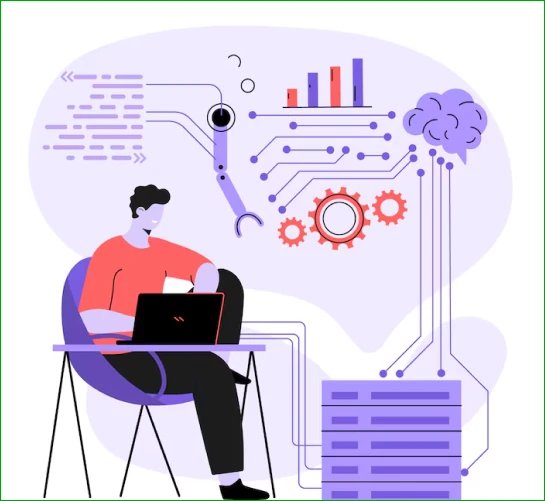 Business Solutions
, SAAS
Business Solutions
, SAAS

05 May, 2024

Businesses are constantly seeking innovative ways to transform raw information into actionable insights. Did you know that the global SaaS BI market was valued at $4.96 billion in 2020 and is projected to hit $15.10 billion by 2025? That’s a whopping growth rate of 24.2%! It’s no surprise, considering the game-changing benefits these platforms offer.
Think intuitive dashboards, advanced analytics, and real-time data processing—all in one accessible, cost-effective package. With SaaS BI, businesses can uncover hidden trends, spot opportunities, and manage risks like never before.
And the best part? No hefty infrastructure investments are required. These cloud-based solutions scale effortlessly to fit your evolving needs, giving you the agility to stay ahead in today’s data-driven world. In this article. let’s explore all the crucial things related to SaaS business intelligence.
Contents
SaaS Business Intelligence is a modern approach. It allows accessing and utilizing business intelligence tools. Mainly, it is a cloud-based software service. SaaS helps the user to gather, analyze, and present data. Such facilities help to make effective decisions. It allows you to access from any device that has an internet connection. These facilities make it convenient and flexible. Rather than purchasing and installing software, users pay a regular fee to access and use the software.

Several functions, including data visualization, dashboards, reporting, and analytics, come with SaaS business intelligence tools. These tools help users to transform raw data into meaningful insights. Scalability is one of the key advantages of SaaS BI. It simplifies the process of accessing and utilizing business intelligence tools. It is a tool that offers flexibility, scalability, and convenience.
When using traditional BI solutions, you may require significant investment in hardware, licenses, and IT infrastructure. In contrast, users pay a regular fee based on usage for SaaS business intelligence solutions, which can reduce challenges.
SaaS BI excels in adaptivity. Traditional BI systems may struggle to accommodate data volume or user demand, requiring additional hardware and infrastructure investment. However, SaaS business intelligence solutions allow you to meet changing business needs, often with minimal interruption easily.
Due to cloud-based architecture, SaaS BI typically offers your company faster deployment and easier integration. Whereas traditional BI systems can be time-consuming and complex.

Traditional BI systems maintenance and updates are the responsibility of your in-house team. With SaaS business intelligence solutions, the service provider handles maintenance and updates.
Hence, SaaS BI offers several advantages in cost, deployment, maintenance, scalability, and accessibility, while traditional BI solutions have their merits. These facilities make it an attractive option for businesses.
Are you going to choose business intelligence software as a service (SaaS) in the industry? Then, when you are going to choose any business intelligence software, you should research what facilities it can provide and whether it has been successful for others or not. It will help you make the right decision. Keep some factors in mind when choosing any SaaS solution.

You should evaluate the features offered by the SaaS BI tool and ensure that they align with your business requirements.
Your required data volumes and user demands should be accommodated by The SaaS BI solution you are going to choose without compromising performance.
The SaaS BI tool you are going to choose should be user-friendly. So that non-technical users are also able to get access and analyze data effectively.
Determine how easily your chosen SaaS BI tool can integrate with your existing systems. Your BI investment can maximize the value by easily integrating SaaS applications.
When selecting a SaaS BI solution it is obvious to prioritize data security. Ensure strong security to protect sensitive data for your vendor implements.
Need to know each hidden cost delicately of the SaaS BI tool you are going to choose. Consider the pricing structure including subscription fees, usage-based charges, and any additional costs. Choose the tool that aligns with your budget and usage patterns.
There are many SaaS distribution channels. You can easily get services from them. But it is important to choose the best one for your organization. Let’s have a look at the top 10 SaaS BI automation tools that could be helpful for you.
Tableau Online is a cloud-based data visualization platform. Shareable and interactive dashboards are allowed here. The drag-and-drop interface, extensive data connectivity options, and robust visualization capabilities are unique features of Tableau Online.
A highly intuitive and user-friendly interface, extensive community support, and powerful data visualization capabilities bring this software to the top position. This tool is now widely adopted across industries for its ease of use.
Another top-ranked SaaS BI Automation Tool is Microsoft Power BI. It provides facilities for a business analytics solution that allows users to visualize and analyze data through interactive dashboards and reports. Its integration with the Microsoft ecosystem, AI-driven insights, and extensive data connectivity options make it unique from other tools.
Why it is top-ranked? Because this tool can provide you with seamless integration with other Microsoft tools, robust data modeling capabilities, continuous updates, and improvements. Its integration capabilities and affordability give it wide acceptance.
Let’s know about Google Data Studio. It is a free data visualization tool. This tool enables you to create adjustable reports and dashboards. Google Data Studio is unique because of its seamless integration with Google products, real-time collaboration, and customizable interactive dashboards.
Free-to-use, intuitive interface, and easy sharing and collaborating on reports make it a top-ranked tool. Its simplicity and integration with other Google services make it successful.
Qlik Sense Cloud is another cloud-based data analytics platform. It allows you to create interactive visualizations and share insights. Interdisciplinary data models, powerful data examination abilities, and multi-cloud deployment options make it extraordinary.
This Qlik Sense Cloud become one of the top-rank BI Automation Tools because of its Interdisciplinary data model that allows for dynamic data examination, user-driven investigation, and intelligence discovery. It is known for its ability to handle large datasets and provide real-time analysis ability.
Domo is another cloud-based business intelligence program that allows a wide range of analytics and visualization. Its unique features include a native mobile app, pre-built connectors, and AI-driven insights.
Robust collaboration features, an extensive range of data connectors, and a user-friendly interface keep Domo on the top, comparatively others. It has become reliable by different organizations for its ease of use and extensive analytics facilities.
Looker is also a cloud-based data analytics platform that enables users to explore, analyze, and share insights from their data. Its specialized features include a centralized data platform, LookML modeling language, and embedded analytics capabilities.
Powerful data modeling capabilities, scalable architecture, and customizable data experiences are the reasons Looker is at the top rank. Its flexibility and ability to create customized data solutions are the reason to make it popular among data-driven organizations.
Let’s learn about another cloud-based business intelligence platform Sisense. This one allows users to analyze, prepare, and visualize complicated data sets. Unique features of Sisense are single-stack architecture, an in-chip analytics engine, and AI-driven automation.
The high-performance analytics engine, ability to handle large and complex datasets, and ease of use facilities make it one of the top-ranking BI platforms. Sisense is well-known for its ability to deliver actionable insights quickly and efficiently.
Zoho Analytics is a self-service BI and analytics platform. It helps users to create and share insightful reports and dashboards. Integration with the Zoho ecosystem, AI-powered assistant, and collaboration tools made this platform unique.
Its intuitive interface, extensive integration options, and Affordable pricing make it a top-ranking product. Due to its affordability, small and medium-sized business organizations are using it widely.
One of the popular cloud-based analytics platforms is Salesforce Einstein Analytics. This platform enables users to visualize, explore, and share insights from Salesforce data. AI-driven perceptions, prognostic analytics, and integration with Salesforce CRM are some of its extraordinary features
Consistent integration with the Salesforce ecosystem, AI-powered guidance, and a mobile-friendly interface keep it in the top-rank position. Salesforce Einstein Analytics became popular among Salesforce users for its ability to uncover actionable insights from CRM data.
IBM Cognos Analytics is also a cloud-based business intelligence. Its analytics platform enables users to access, analyze, and visualize data. These exceptional features include AI-driven analytics, natural language querying, and integrated storytelling abilities.
Intense integration with the IBM ecosystem, progressive analytics capabilities, and enterprise-grade security facilities make it one of the top-ranked platforms. Enterprise users prefer IBM Cognos Analytics for its scalability, security features, and advanced analytics capabilities.
Implementing SaaS BI in your business involves several crucial steps to ensure successful integration and adoption. Here are the three basic steps to help you properly panning, integrate with your business, and adapt it effectively.

Assess your organization’s goals and objectives. Identify key participants and departments that will benefit from your chosen BI initiative. Decide on the specific metrics and key performance indicators (KPIs). This will drive you to make decisions and measure success effectively. Ensure that it aligns with your business objectives.
Moreover, analyze your existing data sources and infrastructure. Identify gaps, inconsistencies, and data quality issues. Decide what data will be relevant and valuable for BI analysis.
Finally, choose the BI solution that will fit your business needs, budget, and technical capabilities. Consider factors such as functionality, scalability, and user-friendly functionality.
Evaluate whether your chosen SaaS BI tool will integrate with your current systems, databases, and applications. Examine compatibility, data transfer methods, and necessary interface engine. Ensure compatibility between different data sources. Consistent data integration between the chosen BI tool and your existing systems is important.
Test connectivity and data transfer method to ensure reliability. If required, customize your chosen BI tool to suit your business requirements. Configure dashboards, reports, and data models to deliver actionable insights to users.
To use the SaaS BI tool effectively, provide comprehensive training to your users. If required, workshops, tutorials, and documentation sessions can be arranged. Promote a data-driven culture within your organization. Brief them on the benefits of BI adoption.
Let the user know the importance of data literacy. When your employees understand how BI can help them make decisions based on data-related information, they will be motivated. Ongoing support and soliciting feedback can improve. If necessary, involve stakeholders in the training process and make employees adopt.
Following these steps, you can effectively implement SaaS BI in your business, empowering users with actionable insights and driving organizational success.
Different types of challenges can be faced when trying to intrigue the SaaS BI tool in your organization. Each Challenge demands careful consideration and strategic resolution. Strategic approaches help overcome the challenges of SaaS Business Intelligence (BI). Here are the three most frequent challenges and ways to overcome them.
Protecting sensitive data within the SaaS BI domain presents a critical challenge. Safeguarding your organization’s data integrity, confidentiality, and availability is essential.
To address this challenge, your businesses must implement comprehensive security protocols. Regular security audits and assessments are essential to identify vulnerabilities. However, raising a culture of security awareness among employees and stakeholders can mitigate risks.
Integrating different data sources and systems is another significant challenge for organizations adopting SaaS BI. With data scattered across various platforms and databases, ensuring consistent integration and interoperability can be paramount.
This challenge is increased by the diverse formats, structures, and protocols employed by different data sources. To overcome integration complexities, businesses should influence advanced integration tools and technologies.
Another formidable challenge for organizations is adopting and engaging with SaaS BI tools. Despite the potential benefits of BI insights, many users may need help in adopting new technologies.
To address this challenge, organizations should emphasize user training. Additionally, establishing user feedback systems can enable your organizations to address user concerns and tailor BI solutions to meet specific needs.
Future trends and innovations in SaaS BI are shaping the landscape of business intelligence, driving advancements and opportunities for organizations by providing facilities like-
Compared to traditional BI solutions, SaaS BI can offer you advantages in cost, deployment speed, maintenance, extensibility, and accessibility. Leading SaaS BI tools like Tableau Online, Microsoft Power BI, and Google Data Studio can provide diverse features that may meet your company’s various business requirements. Implementing SaaS BI requires planning, integration, and adoption strategies. These can ensure successful integration and user engagement.
However, selecting the right solution can be crucial for your company. Hopefully, the article ‘SaaS Business Intelligence: Best Approaches & Top Tools’ will help you choose the right path.
Less-expensive hardware and software upfront can help grow your business. Easy access and use may ensure relief, as you don’t have to worry about updating it regularly. Moreover, you don’t need to be bothered about IT costs.
SaaS helps businesses save money. You don’t need to pay upfront for purchases and changes. As it is easy to access, employees can work from anywhere, so businesses don’t have to worry about IT tasks.
SaaS works by storing software on the Internet instead of your computer. Employees can access it through a web browser. Functioning becomes easy as the provider handles updates and maintenance.